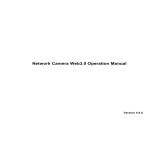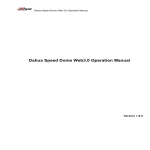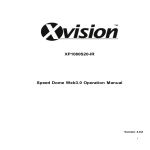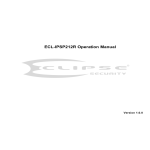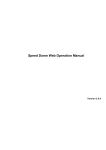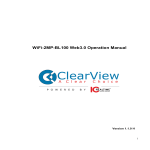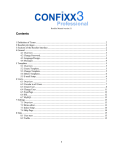Download F4X5 Indoor Series Network Camera User`s Manual
Transcript
Network Camera Web3.0 Operation Manual Version 4.0.2 Zhejiang Dahua Technology CO.,LTD Table of Contents 1 2 3 4 5 Network Connection ...................................................................................................... 1 Main Interface Introduction ............................................................................................ 2 2.1 Log in ................................................................................................................ 2 2.2 Live Interface .................................................................................................... 6 2.3 Encode Setup ................................................................................................... 7 2.4 System Menu .................................................................................................... 8 2.5 Video Window Function Option ......................................................................... 8 2.6 Video Window Setup......................................................................................... 9 2.6.1 Image control .............................................................................................. 9 2.6.2 Hide Image Control ................................................................................... 10 2.6.3 Original size .............................................................................................. 10 2.6.4 Full screen ................................................................................................ 10 2.6.5 Width and height ratio ............................................................................... 10 2.6.6 Fluency Adjustment .................................................................................. 11 2.6.7 Zoom and Focus ....................................................................................... 11 PTZ Control ................................................................................................................. 13 Playback ...................................................................................................................... 16 4.1 Playback Interface .......................................................................................... 16 4.2 Function of Play .............................................................................................. 16 4.3 Date ................................................................................................................ 17 4.4 File List ........................................................................................................... 17 4.5 Progress Bar ................................................................................................... 19 Setup ........................................................................................................................... 20 5.1 Camera ........................................................................................................... 20 5.1.1 Conditions................................................................................................. 20 5.1.2 Video ........................................................................................................ 26 5.1.3 Audio ........................................................................................................ 31 5.2 Network ........................................................................................................... 31 5.2.1 TCP/IP ...................................................................................................... 31 5.2.2 Connection ............................................................................................... 33 5.2.3 PPPoE ...................................................................................................... 35 5.2.4 DDNS ....................................................................................................... 35 5.2.5 IP filter ...................................................................................................... 37 5.2.6 SMTP (e-mail) ........................................................................................ 38 5.2.7 UPnP ........................................................................................................ 39 5.2.8 SNMP ....................................................................................................... 40 5.2.9 Bonjour ..................................................................................................... 42 i 6 7 5.2.10 Multicast ................................................................................................... 43 5.2.11 WIFI .......................................................................................................... 44 5.2.12 802.1x ....................................................................................................... 46 5.2.13 QoS .......................................................................................................... 46 5.2.14 3G ............................................................................................................. 47 5.2.14.1 Dial-up ................................................................................................ 48 5.2.14.2 Mobile Phone ..................................................................................... 49 5.3 Event............................................................................................................... 50 5.3.1 Video detect .............................................................................................. 50 5.3.2 Alarm ........................................................................................................ 55 5.3.3 Abnormity ................................................................................................. 57 5.4 Storage ........................................................................................................... 59 5.4.1 Record Schedule and Snapshot Schedule ............................................... 59 5.4.2 Destination................................................................................................ 60 5.4.3 Record control .......................................................................................... 62 5.5 System ............................................................................................................ 63 5.5.1 General ..................................................................................................... 63 5.5.2 Account..................................................................................................... 64 5.5.3 PTZ ........................................................................................................... 68 5.5.4 Default ...................................................................................................... 69 5.5.5 Import/Export ............................................................................................ 70 5.5.6 Auto Maintenance ..................................................................................... 70 5.5.7 Upgrade .................................................................................................... 71 5.6 Information ...................................................................................................... 71 5.6.1 Version ..................................................................................................... 71 5.6.2 Log............................................................................................................ 72 5.6.3 Online User ............................................................................................... 73 Alarm ........................................................................................................................... 74 Log out ........................................................................................................................ 75 ii Important The following functions are for reference only. Some series products may not support all the functions listed below. iii 1 Network Connection These series network camera products support the Web access and management via PC. Web includes several modules: monitor channel preview, PTZ control, system configuration, alarm and etc. Please follow the steps listed below for network connection. Make sure the network camera has connected to the network properly. Network camera IP address and PC IP address shall be in the same network segment. If there is router, please set the corresponding gateway and subnet mask. Use order ping ***.***.***.***(* network camera address) to check connection is OK or not. 1 2 Main Interface Introduction 2.1 Log in Open IE and input network camera address in the address bar. For example, if your camera IP is 192.168.1.108, then please input http:// 192.168.1.108 in IE address bar. See Figure 2-1. Input your IP address here Figure 2-1 The login interface is shown as below. See Figure 2-2. Please input your user name and password. Default factory name is admin and password is admin. Note: For security reasons, please modify your password after you first login. 2 Figure 2-2 If it is your first time to login in, you may see the interface shown as in Figure 2-3. Figure 2-3 3 Click on “Please click here to download and install the plug-in”. The system pops up warning information to ask you whether run or save this plug-in. See Figure 2-4. Figure 2-4 You must either run or save the file to local and install it. Follow the following steps. See Figure 2-5 and Figure 2-6. 4 Figure 2-5 5 Figure 2-6 When plug-in installation completes, the installation page closes automatically. The web-end will refresh automatically, and then you can view video captured by the camera. 2.2 Live Interface After you logged in, you can see the live monitor window. See Figure 2-7 6 2 1 3 4 Figure 2-7 There are four sections: Section 1: Encode setup bar Section 2: System menu Section 3: Window function option bar Section 4: Window adjust bar 2.3 Encode Setup The encode setup interface is shown as in Figure 2-8. Figure 2-8 Please refer to the following sheet for detailed information. Parameter Function Main stream In normal network width environment, main stream can record audio/video file and realize network monitor. You can set the main stream resolution if your device supports. 7 Sub (Extra) stream If network width is not sufficient, you can use sub stream to realize network monitor. Protocol You can select stream media protocol from the dropdown list. There are three options: TCP/UDP/Multicast 2.4 System Menu System menu is shown as in Figure 2-9. Please refer to chapter 2.2 Live, chapter 3 PTZ, chapter 4 Playback, chapter 5 Setup, chapter 6 Alarm, chapter 7 Log out for detailed information. Figure 2-9 2.5 Video Window Function Option The interface is shown as below. See Figure 2-10 1 2 3 4 5 6 7 8 9 Figure 2-10 Please refer to the following sheet for detailed information. SN Parameter Function 1 Alarm on/off 2 Digital zoom 3 Snapshot 4 Triple snap To control alarm output as: Red: means alarm output. Grey: means alarm ends. When the video is in the original status, click it you can select any zone to zoom in. In the non-original status, you can drag the zoom-in zone in specified range. Right click mouse to restore previous status. Click it; you can use the middle button of the mouse to zoom in/out the video size. You can snapshoot important video by clicking on this button. All images are memorized in system folder: \ picture download (default). You can go to Setup->Camera->Video->Path to modify the local record save path. Click it, system can snap at 1f/s. All images are memorized in system storage folder. 8 5 Record For manual record. All records are memorized in Setup>Camera->Video->Path. 6 Easy focus Click it, you can see there are two parameters on the preview video:AF Peak and AF Max. AF Peak: It is to display the video definition during the focus process. AF Max: It is the most suitable value for the video definition. The close the AF Peak and AF Max is, the better the focus effect is. 7 Audio output Turn on or off audio when you are monitoring. Note: In dual audio device, are 2-ch audio outputs. 8 Bidirectional talk Click it to begin audio talk. You can go to Setup->Camera>Audio to set bidirectional talk mode. 9 Help Click it to open help file. 2.6 Video Window Setup The interface is shown as in Figure 2-11. 1 2 3 4 5 6 Figure 2-11 2.6.1 Image control Click it to open picture setup interface. See Figure 2-12. This interface is on the top right pane. 9 Figure 2-12 Please refer to the following sheet for detailed information. Parameter Function Video setup It is to adjust monitor video brightness. It is to adjust monitor video contrastness. It is to adjust monitor video hue. Note: All the operations here apply to WEB end only. Please go to Setup>Camera->Conditions to adjust corresponding items. It is to adjust monitor video saturation. Reset Restore brightness, contrastness saturation and R hue to systemedefault setup. 2.6.2 Hide Image Control Click this button to display/hide image control interface. 2.6.3 Original size Click this button to go to original size. It is to display the actual size of the video stream. It depends on the resolution of the bit stream. 2.6.4 Full screen Click it to go to full-screen mode. Double click the mouse or click the Esc button to exit the full screen. 2.6.5 Width and height ratio Click it to restore original ratio or suitable window. 10 2.6.6 Fluency Adjustment There are three levels of fluency for you to select. The default is real-time with minimum delay. You may select fluent mode in case connection is slow. 2.6.7 Zoom and Focus Click it to open zoom and focus interface. See Figure 2-13. Note: It is for motorized zoom lens device only. Figure 2-13 Please refer to the following sheet for detailed information. Parameter Zoom Function out Press – to zoom out. in Press + to zoom in. Step length It includes 1, 5, 20 and 100. Restore all Zoom and focus value are both 0. 11 Automatically adjust image definition to best effect. Auto focus Note: Sync focusing device do not have this function. Refresh Sync lens and slide bar location after hardware zooming. 12 3 PTZ Control Please note only IPC-HFxxxx series product support PTZ function. Before PTZ operation, please make sure you have properly set PTZ protocol. (Please go to Setup>System->PTZ to set.). Here you can view direction keys, speed, zoom, focus, iris, preset, tour, pan, scan, pattern, aux close, and PTZ setup button. See Figure 3-1. PTZ direction: PTZ supports eight directions: left/right/up/down/upper left/upper right/bottom left/bottom right. Speed: It controls rotation speed. The step 8 speed is faster than step 1. Default value is 5. Figure 3-1 PTZ setting interface is shown as in Figure 3-2. Here you can set scan, preset, tour, pattern, assistant function and light and wiper. 13 Figure 3-2 Please refer to the following sheet for PTZ setup information. Parameter Function Scan Preset Tour Pattern Click Setup button, you can set scan left and right limit. Move the camera to you desired location and then click left limit button. Then move the camera again and then click right limit button to set a right limit. Input the preset value and then click Preset button, the camera turns to the corresponding position of the preset. Click the Set preset button, you can set a preset. Use direction keys to move the camera to your desired location and then input preset value. Click add button, you have set one preset. The preset value ranges from 1 to 255. (It may vary due to different protocols.) Click the Setup button, you can begin set tour. Input tour value and then click the Set button. The tour value ranges from 1 to 255. (It may vary due to different protocols.) Input preset value in the column. Click Add preset button, you have added one preset in the tour. Note: Repeat the above procedures you can add more presets in one tour. Or you can click delete preset button to remove one preset from the tour. You can input pattern value and then click start button to begin PTZ movement. Please go back to Figure 3-1 to implement camera operation. Then you can click stop button in Figure 3-2. Now you have set one pattern. 14 Parameter Function Assistant Please input the corresponding aux value here. You can select one option and then click AUX on or AUX off button. Light and wiper You can turn on or turn off the light/wiper. 15 4 Playback 4.1 Playback Interface The playback interface is shown as in Figure 4- 1. 2 3 1 4 Figure 4- 1 There are four sections: Section 1: Function of play Section 2: Date Section 3: File list Section 4: Progress bar 4.2 Function of Play The function of play is shown as in Figure 4- 2. 16 Figure 4- 2 1. Play: Play or pause video. 2. Stop: Stop video. 3. Play by frame: Skip to next frame. 4. Slow play: Slow down the video. 5. Quick play: Speed up the video. 6. Silent: Switch off/on sound. 7. Volume: Adjust volume of the video. Note: You must pause video before skipping to next frame. 4.3 Date There are various colors in calendar: Green: means currently selected date. Yellow: means current date has record file. Blue: means current date has record file which is/are selected. Only file types selected will be displayed in progress bar and list. 4.4 File List The file list is shown as in Figure 4- 3. 17 Figure 4- 3 Click on to enter file list. Double click on record file in the list and this file will be played. You can view file size, start and end time. Record type has four catagories: Green means general record. Yellow means motion detection record. Red means alarm record. Blue means manual record. Search: You can search record files within selected time interval. 18 Download: Click on this button, you can download file to PC. Back: Click on this button, you will go back to calendar page. 4.5 Progress Bar means video in past 24 hours. means video in past 2 hours. means video in past 1 hour. means video in past 30 min. 19 5 Setup 5.1 Camera 5.1.1 Conditions Here you can view device property information. Slight differences may be found due to different network camera series. The setups become valid immediately after you set. See Figure 5-1. Figure 5-1 Please refer to the following sheet for detailed information. Parameter Function Config File You may select general, day and night mode. Brightness It is to adjust monitor window bright. You can adjust this value if the video is too dark or too bright. The larger the number, the bright the video is. When you input the value here, the bright section and the dark section of the video will be adjusted accordingly. Please note the video may become hazy if the value is too high. The value ranges from 0 to 100. The recommended value ranges from 40 to 60. The default value is 50. 20 Contrast It is to adjust monitor window contrast. The larger the number, the higher the contrast is. You can use this function when the whole video bright is OK but the contrast is not proper. Please note the video may become hazy if the value is too low. If this value is too high, the dark section may lack brightness while the bright section may over exposure . The value ranges from 0 to 100. The recommended value ranges from 40 to 60. The default value is 50. Saturation It is to adjust monitor window saturation. The larger the number, the strong the color is. This value has no effect on the general brightness of the whole video. The video color may become too strong if the value is too high. For the grey part of the video, the distortion may occur if the white balance is not accurate. Please note the video may not be attractive if the value is too low. The value ranges from 0 to 100. The recommended value ranges from 40 to 60. The default value is 50. Sharpness The value here is to adjust the edge of the video. The larger the value is, the clear the edge is and vice versa. Please note there is noise if the value here is too high. The value ranges from 0 to 100. The recommended value ranges from 40 to 60. The default value is 50. Anti-flicker Outdoor: In this mode, you can switch exposure mode to get the effect under the corresponding exposure mode. 50Hz: When the current is 50Hz, system can auto adjust the exposure according to the environment brightness in case there is any strip. 60Hz: When the current is 60Hz, system can auto adjust the exposure according to the environment brightness in case there is any strip. Auto Exposure Mode The video whole brightness can automatically change within the proper exposure range according to the different environments. The higher the gain max value is, the lower the noise is. 21 Low noise Low motion blur Manual Auto Iris The video whole brightness can automatically change within the proper exposure range according to the different environments. The higher the gain max value is, the lower the noise is. For the same environments, the noise of the low noise mode shall be smaller than the noise of the auto mode. The video whole brightness can automatically change within the proper exposure range according to the different environments. The lower the exposure max value is, the week the tail is. For the same environments, the noise of the low motion blur mode shall be smaller than that of the auto mode. It is to display manual exposure value. Before the setup, please make sure you have installed the auto iris. You can check the box before ON to enable this function. The auto iris may change if the light becomes different. When you disable this function, the iris is at the max. System does not add the auto iris function in the exposure control. This function is on by default. Scene Mode It is to set the white balance mode. It has effect on the general hue of the video. This function is on by default. You can select the different scene mode such as auto, sunny, cloudy, home, office, night, disable and etc to adjust the video to the best quality. Auto: The auto white balance is on. System can auto compensate the color temperature to make sure the vide color is proper. Sunny: The threshold of the white balance is in the sunny mode. Night: The threshold of the white balance is in the night mode. Customized: You can set the gain of the red/blue channel. The value reneges from 0 to 100. 22 Day&Night Backlight Mode It is to set device color and the B/W mode switch. When config file is general, the default is auto. When config file is day, the default is color. When config file is night, the default is black & white. Color: Device outputs the color video. Auto: Device auto select to output the color or the B/W video according to the device feature (The general bright of the video or there is IR light or not.) B/W: The device outputs the black and white video. BLC The device auto exposures according to the environments situation so that the darkest area of the video is cleared WDR For the WDR scene, this function can lower the high bright section and enhance the brightness of the low bright section. So that you can view these two sections clearly at the same time. The value ranges from 1 to 100. When you switch the camera from no-WDR mode to the WDR mode, system may lose several seconds record video. HLC After you enabled HLC function, the device can lower the brightness of the brightest section according to the HLC control level. It can reduce the area of the halo and lower the brightness of the whole video. The value ranges from 0 to 100. The default value is 50 when HLC is on. HLC is enabled only when anti-flicker is outdoor and exposure mode is auto. Off It is to disable the BLC function. Please note this function is disabled by default. Full-screen test Click the screen test. button on the video window, you can begin full- Flip It is to switch video up and bottom limit. This function is disabled by default. The video resolution shall be 720P or below if you want to flip 90°. Mirror It is to switch video left and right limit. This function is disabled by default. 23 Cancel It is to cancel the operation in current interface and restore previously saved operation. Default It is to set device default setup. The profile management interface is shown as in Figure 5-2. Figure 5-2 Profile management has three modes: general, full time and schedule. If you select general, the video will be configured as general. If you select full time, you must select either day or night, and the video will be configured accordingly. If you select schedule, you can decide detained time interval. Important The setup becomes immediately after you set. IPC-3110 series product does not support the low noise mode, low motion blur, defend flicker mode, digital WDR, HLC, flip, mirror and etc functions. You can see WDR option only if your camera supports WDR function. System does not support long-time exposure or low noise mode. Profile management has three modes: general, full time and schedule. If you select general, the video will be configured as general. Figure 5-3 24 If you select full time, you must select either day or night, and the video will be configured accordingly. Figure 5-4 If you select schedule, you can decide detained time period. One period is day time, and the other is night time. See Figure 5-4. Figure 5-5 Please refer to Ch 2.6. Important The setup becomes immediately after you set and save. IPC-3110 series product does not support the low noise mode, low motion blur, defend flicker mode, digital WDR, HLC, flip, mirror and etc functions. You can see WDR option only if your camera supports WDR function. System does not support long-time exposure or low noise mode. 25 Zoom and focus function are for motorized focus device only. 5.1.2 Video 5.1.2.1 Video bit stream The video bit stream interface is shown as below. See Figure 5-6. Figure 5-6 Please refer to the following sheet for detailed information. Parameter Function Main stream It includes general stream, motion stream and alarm stream. You can select different encode frame rates form different recorded events. Bit stream type System supports active control frame function (ACF). It allows you to record in different frame rates. For example, you can use high frame rate to record important events, record scheduled event in lower frame rate and it allows you to set different frame rates for motion detection record and alarm record. 26 Parameter Function Encode mode There are three options: H.264 (main profile standard), H.264H (high profile standard), H.264B (baseline standard)encode and MJPG encode. H.264 :Main Profile encode mode. H.264H : High Profile encode mode. H.264B :Baseline Profile encode mode MJPEG :In this encode mode, the video needs larger bit stream to guarantee the video definition. You can use the max bit stream value in the recommend bit to get the better video output effect. Resolution There are multiple resolutions. You can select from the dropdown list. For each resolution, the recommended bit stream value is different. Important You can not set a resolution higher than 720P (not including 720P) when the flip function is in process. Frame Rate PAL: 1~25f/s,NTSC: 1~30f/s.. The frame rate may vary due to different resolutions. Bit Rate Type There are two options: VBR and CBR. Please note, you can set video quality in VBR mode. Reference Bit Stream Reference bit rate value according to the resolution and frame rate you have set. Bit Rate I Frame In VBR, the bit rate here is the max value. In CBR, it is a fixed value. See reference bit stream for recommended value. Here you can set the P frame amount between two I frames. The value ranges from 1 to 150. Default value is 50. Recommended value is frame rate *2. Watermark Sub stream Enable Bit stream type This function allows you to verify the video is tampered or not. Here you can select watermark bit stream, watermark mode and watermark character. Default character is DigitalCCTV. The max length is 85-digit. The character can only include number, character and underline. Please check the box here to enable extra stream function. This function is enabled by default. General bit stream. 27 Parameter Function Encode mode There are three options: H.264(main profile standard, H.264H (high profile standard), H.264B(baseline standard)encode and MJPG encode. The H.264, H.264H and H.264B both are H264 bit stream. H.264 is the Main Profile encode and the H.264B is the Baseline Profile encode mode. H.264B is for Blackberry cell phone to realize the monitor. You need to enable the sub stream function in your camera and set the resolution as CIF. Then you can monitor via the Blackberry cell phone. MJPEG: In this encode mode, the video needs to large bit stream to guarantee the video definition. You can use the max bit stream value in the recommend bit to get the better video output effect. Resolution There are multiple resolutions. You can select from the dropdown list. For each resolution, the recommended bit stream value is different. Frame Rate PAL: 1~25f/s,NTSC: 1~30f/s.. The frame rate may vary due to different resolutions. Bit Rate Type There are two options: VBR and CBR. Please note, you can set video quality in VBR mode. Recommended Bit Recommended bit rate value according to the resolution and frame rate you have set. Bit Rate I Frame In CBR, the bit rate here is the max value. In dynamic video, system needs to low frame rate or video quality to guarantee the value. The value is null in VBR mode. Please refer to recommend bit rate for the detailed information. Here you can set the P frame amount between two I frames. The value ranges from 1 to 150. Default value is 50. Recommended value is frame rate *2. 5.1.2.2 Snapshot The snapshot interface is shown as in Figure 5-7. 28 Figure 5-7 Please refer to the following sheet for detailed information. Parameter Function Snapshot type There are two modes: general (schedule) and Event (activation). Image size It is the same with the resolution of the main stream. Quality It is to set the image quality. There are six levels. Snapshot bit stream It is to set snapshot bit rate as main or sub. Interval It is to set snapshot frequency. The value ranges from 1s to 7s. 5.1.2.3 Video Overlay The video overlay interface is shown as in Figure 5-8. 29 Figure 5-8 Please refer to the following sheet for detailed information. Parameter Function Privacy mask Time Title Channel Title Here you can privacy mask the specified video in the monitor video. System max supports 4 privacy mask zones. You can enable this function so that system overlays time information in video window. You can use the mouse to drag the time tile position. You can enable this function so that system overlays channel information in video window. You can use the mouse to drag the channel tile position. 5.1.2.4 Path The storage path interface is shown as in Figure 5-9. Here you can set snap image saved path ( ( in the preview interface) and the record storage path in the preview interface).The default setup is C:\PictureDownload and C:\RecordDownload. Please click the Save button to save current setup. 30 Figure 5-9 5.1.3 Audio Please note IPC-HDB3xxxC series product does not support audio function. The audio interface is shown as below. See Figure 5-10. Figure 5-10 Please refer to the following sheet for detailed information. Parameter Function Audio enable Main stream: Recorded file only contains video by default. You need to check the audio box here to enable audio function. Sub (Extra) stream: Recorded file only contains video by default. You need to check the audio box here to enable audio function. Encode mode The encode mode of the main stream and extra stream include PCM, G.711A and G.711Mu. The setup here is for audio encode mode and the bidirectional talk encode both. 5.2 Network 5.2.1 TCP/IP 31 The TCP/IP interface is shown as in Figure 5-11. Figure 5-11 Please refer to the following sheet for detailed information. Parameter Function Host Name It is to set current host device name. It max supports 32-digit character. Ethernet Card Please select the Ethernet port. It is for the wire LAN by default. Please note for the -W series product, it has the wireless network card, and you can modify the default Ethernet port setup. Please note the device needs to reboot to activate the new setup once you modify the default setup. Mode Mac Address There are two modes: static mode and the DHCP mode. The IP/submask/gateway are null when you select the DHCP mode to auto search the IP. If you select the static mode, you need to set the IP/submask/gateway manually. If you select the DHCP mode, you can view the IP/submask/gateway from the DHCP. If you switch from the DHCP mode to the static mode, you need to reset the IP parameters. Besides, IP/submask/gateway and DHCP are read-only when the PPPoE dial is OK. It is to display hose Mac address. 32 IP Version It is to select IP version. IPV4 or IPV6. You can access the IP address of these two version. IP Address Please use the keyboard to input the corresponding number to modify the IP address and then set the corresponding subnet mask and the default gateway. Preferred DNS DNS IP address. Alternate DNS Alternate DNS IP address. Enable ARP/Ping set device IP address service. You can use ARP/Ping command to modify or set the device IP address if you know the device MAC address. Before the operation, please make sure the network camera and the PC in the same LAN. This function is on by default. You can refer to the steps listed below. Step 1: Get an IP address. Set the network camera and the PC in the same LAN. Step 2: Get the physical address from the label of the network camera. Step 3: Go to the Run interface and then input the following commands. arp –s <IP Address> <MAC> ping –l 480 –t <IP Address> Such as:arp -s 192.168.0.125 11-40-8c-18-10-11 ping -l 480 -t 192.168.0.125 Step 4: Reboot the device. Step 5: You can see the setup is OK if you can see there are output information such as “Reply from 192.168.0.125 …” from the command output lines. Now you can close the command line. Step 6: Open the browse and then input http://<IP addres>. Click the Enter button, you can access now. 5.2.2 Connection The connection interface is shown as in Figure 5-12. 33 Figure 5-12 Please refer to the following sheet for detailed information. Parameter Function Max connection It is the max Web connection for the same device. The value ranges from 1 to 20. The max connection amount is 20. TCP port The default value is 37777. You can input the actual port number if necessary. UDP port The default value is 37778. You can input the actual port number if necessary. HTTP port The default value is 80. You can input the actual port number if necessary. RTSP port The default value is 554. Rtsp stream query format is: Main stream: rtsp://username:password@ip:port/cam/realmonitor?channel=1&subtype=0 Sub stream: rtsp://username:password@ip:port/cam/realmonitor?channel=1&subtype=1 You need to input the following four items manually. username/password/IP and port. The IP is device IP and the port default value is 554. You can leave it in blank if it is the default value. Follow standard RTP protocol and when encode mode is MJPEG, the max resolution only supports 2040*2040. 34 HTTPs Enable The default value is 443. 5.2.3 PPPoE The PPPoE interface is shown as in Figure 5-13. Input the PPPoE user name and password you get from the IPS (internet service provider) and enable PPPoE function. Please save current setup and then reboot the device to get the setup activated. Device connects to the internet via PPPoE after reboot. You can get the IP address in the WAN from the IP address column. When PPPoE is on, please disable UPnP to avoid influence on dial-up. Please note, you need to go to the IP address item to via the device current device information. You can access the client-end via this address. Figure 5-13 5.2.4 DDNS The DDNS interface is shown as in Figure 5-14. The DDNS is to set to connect the various servers so that you can access the system via the server. Please go to the corresponding service website to apply a domain name and then access the system via the domain. It works even your IP address has changed. When the device connects to WLAN, you should disable UPnP. 35 Figure 5-14 Please refer to the following sheet for detailed information. Parameter Function Server Type You can select DDNS protocol from the dropdown list and then enable DDNS function. The Dahua DDNS means you use your self-defined private protocol to realize DDNS function. Server Address DDNS server IP address. Under Dahua DDNS the default server address is www.dahuaddns.com Mode The default is auto, and you can select manual. Domain Name Auto and self-defined domain names are both MAC address.dahuaddns.com. You can self-define prefix. Test It is to test domain name. It is available only under manual mode. Username The user name you input to log in the server. Optional. The DDNS interface is shown as in Figure 5-15. 36 Figure 5-15 Parameter Function Server Type You can select DDNS protocol from the dropdown list and then enable DDNS function. The Dahua DDNS protocol means you use your self-defined private protocol to realize DDNS function. Server Address DDNS server IP address Domain Name Your self-defined domain name. Username The user name you input to log in the server. Password The password you input to log in the server. Update period Device sends out alive signal to the server regularly. You can set interval value between the device and DDNS server here. 5.2.5 IP filter The IP filter interface is shown as in Figure 5-16. You can enable IP filter function so that some specified IP/MAC user can access the network camera. You can add IP address or IP address section. If you do not check the box here, it means there is on access limit. Here you can add IP address and MAC address. You must add these address before enabling the trusted sites. Please note: You must set MAC address in the same network segment. 37 Figure 5-16 5.2.6 SMTP (e-mail) The SMTP interface is shown as in Figure 5-17. Figure 5-17 Please refer to the following sheet for detailed information. 38 Parameter Function SMTP Server Input server address and then enable this function. Port Default value is 25. You can modify it if necessary. Anonymity For the server supports the anonymity function. You can auto login anonymously. You do not need to input the user name, password and the sender information. User Name The user name of the sender email account. Password The password of sender email account. Sender Sender email address. Authentication (Encryption mode) You can select SSL or none. Title (Subject) Input email subject here. Attachment System can send out the email of the snapshot picture once you check the box here. Mail receiver Input receiver email address here. Max three addresses. Interval The send interval ranges from 0 to 3600 seconds. 0 means there is no interval. Please note system will not send out the email immediately when the alarm occurs. When the alarm, motion detection or the abnormity event activates the email, system sends out the email according to the interval you specified here. This function is very useful when there are too many emails activated by the abnormity events, which may result in heavy load for the email server. Please check the box here to enable this function. Health mail enable Update period (interval) Email test This function allows the system to send out the test email to check the connection is OK or not. Please check the box to enable this function and then set the corresponding interval. System can send out the email regularly as you set here. The system will automatically sent out a email once to test the connection is OK or not .Before the email test, please save the email setup information. 5.2.7 UPnP It allows you to establish the mapping relationship between the LAN and the public network. Here you can also add, modify or remove UPnP item. For UPnP on different routers, you must disable UPnP function. See Figure 5-18. 39 In the Windows OS, From Start->Control Panel->Add or remove programs. Click the “Add/Remove Windows Components” and then select the “Network Services” from the Windows Components Wizard. Click the Details button and then check the “Internet Gateway Device Discovery and Control client” and “UPnP User Interface”. Please click OK to begin installation. Enable UPnP from the Web. If your UPnP is enabled in the Windows OS, the network camera can auto detect it via the “My Network Places” Figure 5-18 5.2.8 SNMP The SNMP interface is shown as in Figure 5-19. The SNMP allows the communication between the network management work station software and the proxy of the managed device. Please install the software such as MG MibBrowser 8.0c software or establish the SNMP service before you use this function. You need to reboot the device to activate the new setup. 40 Figure 5-19 Please refer to the following sheet for detailed information. Parameter Function SNMP port The listening port of the proxy program of the device. It is a UDP port not a TCP port. The value ranges from 1 to 65535. The default value is 161 Read community It is a string. It is a command between the manage process and the proxy process. It defined the authentication, access control and the management relationship between one proxy and one group of the managers. Please make sure the device and the proxy are the same. The read community will read all the objects the SNMP supported in the specified name. The default setup is public. It is a string. It is a command between the manage process and the proxy process. It defined the authentication, access control and the management relationship between one proxy and one group of the managers. Please make sure the device and the proxy are the same. The read community will read/write/access all the objects the SNMP supported in the specified name. The default setup is write. The destination address of the Trap information from the proxy program of the device. Write community Trap address 41 Parameter Function Trap port The destination port of the Trap information from the proxy program of the device. It is for the gateway device and the client-end PC in the LAN to exchange the information. It is a non-protocol connection port. It has no effect on the network applications. It is a UDP port not TCP port. The value ranges from 1 to 165535. The default value is 162. SNMP version Username readonly Authentication Authentication password SNMP V1: system only processes the information of V1. SNMP V2: system only processes the information of V2. SNMP V3: you can set user name and password. There is account security verification when the server wants to connect to the device. At the same time, the v1 and V2 is null and cannot select. Only when SNMP version is SNMP v3, you shall config this parameter. The default is public. Only when SNMP version is SNMP v3, you shall config this parameter. You can select either MD5 or SHA. The default is MD5. Only when SNMP version is SNMP v3, you shall config this parameter. Password requires min of 8 characters. Encryption Only when SNMP version is SNMP v3, you shall config this parameter. The default is CBC-DES. Encryption password Only when SNMP version is SNMP v3, you shall config this parameter. Password requires min of 8 characters. Username read/write Only when SNMP version is SNMP v3, you shall config this parameter. The default is private. Authentication Only when SNMP version is SNMP v3, you shall config this parameter. You can select either MD5 or SHA. The default is MD5. Only when SNMP version is SNMP v3, you shall config this parameter. Password requires min of 8 characters. Authentication password Encryption Only when SNMP version is SNMP v3, you shall config this parameter. The default is CBC-DES. Encryption password Only when SNMP version is SNMP v3, you shall config this parameter. Password requires min of 8 characters. 5.2.9 Bonjour The Bonjour interface is shown as below. See Figure 5-20. Bonjour is based on the multicast DNS service from the Apple. The Bonjour device can automatically broadcast its service information and listen to the service information from other device. 42 You can use the browse of the Bonjour service in the same LAN to search the network camera device and then access if you do not know the network camera information such as IP address. You can view the server name when the network camera is detected by the Bonjour. Please note the safari browse support this function. Click the “Display All Bookmarks: and open the Bonjour, system can auto detect the network camera of the Bonjour function in the LAN. Figure 5-20 5.2.10 Multicast The multicast interface is shown as in Figure 5-21. Multicast is a transmission mode of data packet. When there is multiple-host to receive the same data packet, multiple-cast is the best option to reduce the broad width and the CPU load. The source host can just send out one data to transit. This function also depends on the relationship of the group member and group of the outer. Here you can set multicast address and port. You also need to go to Live interface to set the protocol as Multicast. 43 Figure 5-21 Please refer to the following sheet for detailed information. Parameter Function Enable Select to enable multicast function. Main stream and sub stream cannot be used at the same time. Multicast address Main/sub stream multicast address is 239.255.42.42 and its range is 224.0.0.0~239.255.255.255. Port Multicast port. Main stream is 36666, sub stream is 36667and the range is 1025~65534. 5.2.11 WIFI Please note this function is for the device of WIFI module. The WIFI interface is shown as in Figure 5-22. 44 Figure 5-22 Please check the box to enable WIFI function and then click the Search SSID button. Now you can view all the wireless network information in the following list. Double click a name to connect to it. Click on add wireless ID, and add designated ID in dialog box. Please make sure that you can find the just added ID in list, otherwise you cannot use this ID. See Figure 5-23. Figure 5-23 45 5.2.12 802.1x 802.1x (port based network access control protocol) supports manual selection of authentication method to control if device connected to LAN can join the LAN. It well supports authentication, charging, safety and management requirement of network . See Figure 5-24. Figure 5-24 Please refer to the following sheet for detailed information. Parameter Function Authentication PEAP (protected EAP protocol). Username It needs the username to login, which is authenticated by the server. Password Please input password here. 5.2.13 QoS The QoS interface is shown as below. See Figure 5-25. Qos (Quality of Service) is network security mechanism. It is a technology to fix the network delay and jam problem and etc. For the network service, the quality of service includes the transmission bandwidth, 46 delay, the packet loss and etc. We can guarantee the transmission bandwidth, lower the delay, reduce the loss of the data packet and anti-dither to enhance the quality. We can set the DSCP (Differentiated Services Code Point) of the IP to distinguish the data packet so that the router or the hub can provide different services for various data packets. It can select the different queues according to the priority of the packets and select the bandwidth of the each queue. It can also discard at the different ratio when the broad bandwidth is jam. Figure 5-25 Please refer to the following sheet for detailed information. Parameter Function Real-time monitor The value ranges from 0 to 63. The router or the switcher can provide different service for various data packets. Command The value ranges from 0 to 63. The router or the switcher can provide different service for various data packets. Enable wireless QoS Check it to enable QoS. 5.2.14 3G Note: This function is only for series with 3G module. The 3G interface is shown as in Figure 5-26. 47 Figure 5-26 5.2.14.1 Dial-up The dial-up interface is shown as in Figure 5-27. Figure 5-27 48 Please refer to the following sheet for detailed information. Parameter Function Wireless connection type The default is auto and it supports dial-up, sms and incoming call. Enable Check to enable 3G module. Authentication This function depends on your local 3G provider. Dial-up This function depends on your local 3G provider. Username This function depends on your local 3G provider. Password This function depends on your local 3G provider. Auto period It is period for device to receive 3G signal every 30s other than scheduled period. The default is 30s. Interval You can set dial-up interval. You also can dial if you enable dial-up/sms. The dial-up/sms and dial-up interval is related. IP address It displays received IP when 3G dial-up succeeds. 5.2.14.2 Mobile Phone The mobile phone interface is shown as in Figure 5-28. 49 Figure 5-28 Please refer to the following sheet for detailed information. Parameter Function SMS sending In event management, check corresponding sms, so when there is event, a sms will be sent to mobile phone in corresponding receiving list. To use this function, you shall check sms enable in event management interface. SMS enable Mobile phone numbers in the list can enable/disable dial-up function and reboot device by sending sms to SIM card in the device. Tel Activation Mobile phone numbers in the list can call the SIM card in the device to enable/disable dial-up function. 5.3 Event 5.3.1 Video detect 5.3.1.1 Motion Detect The motion detect interface is shown as in Figure 5-29. 50 Figure 5-29 Please refer to the following sheet for detailed information. Parameter Function Enable You need to check the box to enable motion detection function. Working Period Here you can set arm/disarm period. Click on set button to open period setup menu. System only memorizes one event during the anti-dither period. The value ranges from 0s to 100s. Here you can set motion detection region and its sensitivity and area. The default covers all regions. You must click on save before enabling your setup. When record is enabled, you can trigger motion detection to activate record. Anti-dither Area Record Record Delay System can delay the record for specified time after alarm ended. The value ranges from 10s to 300s. Relay out Enable alarm activation function. You need to select alarm output port so that system can activate corresponding alarm device when alarm occurs. Alarm Delay System can delay the alarm output for specified time after alarm ended. The value ranges from 10s to 300s. Function Parameter Send Email PTZ If you enabled this function, System can send out email to alert you when alarm occurs and ends. Here you can set PTZ movement when alarm occurs. Such as go to preset x when there is an alarm. The event type includes: preset, tour and pattern. 51 Parameter Function Snapshot You need to check the box here so that system can backup motion detection snapshot file. See Figure 5-27. Figure 5-30 See Figure 5-31. 52 Figure 5-31 Please refer to the following sheet for detailed information. Parameter Function Sensitivity It is sensitivity of brightness as motion detection is more possible to be trigger with high sensitivity. You can set up to four areas. The range is 0~100. The recommenced value is 30~70. The default is 50. Area threshold It is to check target object area related to detection area. The lower the area threshold, the easier to trigger motion detection. You can set up to four areas. The range is 0~100. The recommenced value is 10~50. Remove all Clear all areas. Delete Delete selected area. 5.3.1.2 Video Masking The video masking interface is shown as in Figure 5-32 and Figure 5-33. 53 Figure 5-32 Figure 5-33 Please refer to the following sheet for detailed information. Parameter Function Enable You need to check the box to enable this function. 54 Parameter Working period Function Video masking function becomes activated in the specified periods. There are six periods in one day. Please draw a circle to enable corresponding period. Select date. If you do not select, current setup applies to today only. You can select all week column to apply to the whole week. Click OK button, system goes back to motion detection interface, please click save button to exit. Record After record is enabled, video masking can activate video. Record delay System can delay the record for specified time after alarm ended. The value ranges from 10s to 300s. Relay out Enable alarm activation function. You need to select alarm output port so that system can activate corresponding alarm device when alarm occurs. Alarm delay System can delay the alarm output for specified time after alarm ended. The value ranges from 10s to 300s. Send Email If you enabled this function, System can send out email to alert you when alarm occurs. PTZ Snapshot Here you can set PTZ movement when alarm occurs. Such as go to preset x when there is an alarm. The event type includes: preset, tour and pattern. After snapshot is enabled and alarm happens, the system will automatically snapshot and alarm. 5.3.2 Alarm Please note IPC-HDB3xxxC series product does not support this function. 5.3.2.1 Alarm activation The alarm activation interface is shown as in Figure 5-34. 55 Figure 5-34 Please refer to the following sheet for detailed information. Parameter Function Enable You need to check the box to enable this function. Alarm input The default is alarm 1 and for some devices may be alarm 2. Working period Anti-dither This function becomes activated in the specified periods. There are six periods in one day. Please draw a circle to enable corresponding period. Select date. If you do not select, current setup applies to today only. You can select all week column to apply to the whole week. Click OK button, system goes back to motion detection interface; please click save button to exit. System only memorizes one event during the anti-dither period. The value ranges from 0s to 100s. Sensor type There are two options: NO/NC. Record System auto activates motion detection channel to record once alarm occurs (working with motion detection function). Record Delay System can delay the record for specified time after alarm ended. The value ranges from 10s to 300s. Relay out There is 1-channel alarm output. Corresponding to motion detection alarm output port. Enable alarm activation function. You need to select alarm output port so that system can activate corresponding alarm device when alarm occurs. 56 Parameter Function Alarm delay System can delay the alarm output for specified time after alarm ended. The value ranges from 10s to 300s. Send Email If you enabled this function, System can send out email to alert you when alarm occurs and ends. PTZ Snapshot Here you can set PTZ movement when alarm occurs. Such as go to preset x when there is an alarm. The event type includes: preset, tour and pattern. After you enabled snapshot, the system will automatically snapshot if alarm occurs. 5.3.3 Abnormity It includes five statuses: No SD card, capacity warning, SD card error, and disconnection and IP conflict. There are two interfaces for you reference. See Figure 5-35 through Figure 5-39. Figure 5-35 Figure 5-36 57 Figure 5-37 Figure 5-38 Figure 5-39 Please refer to the following sheet for detailed information. Parameter Event Type Function The abnormal events include: no disk, no space, disk error, net error, offline, IP conflict. Threshold: You can set the minimum percentage value here. The device can alarm when capacity is not sufficient. You need to draw a circle to enable this function. 58 Parameter Function Record System auto activates channel to record once alarm occurs (For offline type only. See Figure 5-39. ). You need to check the box to enable this function. Record delay System can delay the record for specified time after alarm ended. The value ranges from 10s to 300s. Relay Out The corresponding alarm output channel when alarm occurs. You need to check the box to enable this function. Relay out delay The alarm output can delay for the specified time after alarm stops. The value ranges from 10s to 300s. Send email If you enable this function, system can send out email to alarm the specified user. This function is invalid when network is offline or IP conflict occurs. 5.4 Storage 5.4.1 Record Schedule and Snapshot Schedule In these two interfaces, you can add or remove the schedule record/snapshot setup. See Figure 5-40 and Figure 5-38. There are three record modes: general (auto), motion detect and alarm. There are six periods in one day. Please make sure you have enabled the corresponding record mode in the Setup->Storage>Conditions. You can view the current time period setup from the color bar. Green color stands for the general record/snapshot. Yellow color stands for the motion detect record/snapshot.. Red color stands for the alarm record/snapshot. 59 Figure 5-40 Figure 5-41 You can set specified dates as holiday. When snapshot of holiday is enabled, the selected dates will be snapshot/recorded according to holiday setup. 5.4.2 Destination The destination interface is shown as in Figure 5-42. It is to set the storage mode of the network camera record file or snapshot pictures. There are two options: local/FTP. You can only select one mode. System can save according to the event types. It is corresponding to the three modes (general/motion/alarm)in the Schedule interface. Please check the box to enable the save functions. 60 Figure 5-42 Please refer to the following sheet for detailed information. Parameter Function Event Type It includes: general, motion detect and alarm. Local It saved in the Micro SD card. FTP It saved in the FTP server. The local interface is shown as in Figure 5-43. Here you can view local Micro SD card or disk information. You can also operate the read-only, write-only, hot swap and format operation. Figure 5-43 The FTP interface is shown as in Figure 5-44. You need to check the box to enable the FTP function. When network disconnect occurred or there is malfunction. Emergency storage can save the record/snapshot picture to the local Micro SD card. 61 Figure 5-44 5.4.3 Record control The record control interface is shown as in Figure 5-45. Figure 5-45 Please refer to the following sheet for detailed information. Parameter Function Pack Duration Here you can select file size. Default setup is 8 minutes. Pre-record Please input pre-record value here. For example, system can record the four seconds video in the buffer. The record begins from the fifth second. Disk Full There are two options: stop recording or overwrite the previous files when HDD is full. Stop: Current working HDD is overwriting or current HDD is full, it will stop record. Overwrite: Current working HDD is full; it will overwrite the previous file. 62 Record mode There are three modes: Auto/manual/close. Record stream There are two options: main stream and sub stream. 5.5 System 5.5.1 General The general interface includes the local host setup and the date/time setup. 5.5.1.1 Local host The local host interface is shown as in Figure 5-46. Figure 5-46 Please refer to the following sheet for detailed information. Parameter Function Device No It is to set device name. Video Standard This is to display video standard such as PAL. Language You can select the language from the dropdown list. 5.5.1.2 Date and time The date and time interface is shown as in Figure 5-47. 63 Figure 5-47 Please refer to the following sheet for detailed information. Parameter Function Date format Here you can select date format from the dropdown list. Time Format There are two options: 24-H and 12-H. Time zone The time zone of the device. System time It is to set system time. It becomes valid after you set. Sync PC You can click this button to save the system time as your PC current time. DST Here you can set day night save time begin time and end time. You can set according to the date format or according to the week format. NTP You can check the box to enable NTP function. NTP server You can set the time server address. Port It is to set the time server port. Update period It is to set the sync periods between the device and the time server. 5.5.2 Account 64 Note: For the character in the following user name or the user group name, system max supports 15digits. The valid string includes: character, number, and underline. The user amount is 18 and the group amount is 8 when the device is shipped out of the factory. The factory default setup includes two levels: user and admin. You can set the corresponding group and then set the rights for the respective user in the specified groups. User management adopts group/user modes. The user name and the group name shall be unique. One user shall be included in only one group. 5.5.2.1 User name In this interface you can enable anonymity login, add/remove user and modify user name. See Figure 5-48. Figure 5-48 Enable anonymity login: Enable anonymity login, and input IP. No username or password is required, you can log in by anonymity (with limited rights). You can click logout to end your session. Add user: It is to add a name to group and set the user rights. See Figure 5-49. There are four default users: admin/888888/666666 and hidden user “default”. Except user 6666, other users have administrator right. The user 666666 can only have the monitor rights,. Hidden user “default” is for system interior use only and cannot be deleted. When there is no login user, hidden user “default” automatically login. You can set some rights such as monitor for this user so that you can view some channel view without login. Here you can input the user name and password and then select one group for current user. Please note the user rights shall not exceed the group right setup. For convenient setup, please make sure the general user has the lower rights setup than the admin. 65 Figure 5-49 Modify user It is to modify the user property, belonging group, password and rights. See Figure 5-50. Modify password It is to modify the user password. You need to input the old password and then input the new password twice to confirm the new setup. Please click the OK button to save. Please note, the password ranges from 0-digit to 32-digit. It shall include the number and letter only. For the user who has the account rights, he can modify the password of other users. 66 Figure 5-50 5.5.2.2 Group The group management interface can add/remove group, modify group password and etc. The interface is shown as in Figure 5-51. Figure 5-51 Add group: It is to add group and set its corresponding rights. See Figure 5-52. Please input the group name and then check the box to select the corresponding rights. It includes: preview, playback, record control, PTZ control and etc. 67 Figure 5-52 Modify group Click the modify group button, you can see an interface is shown as in Figure 5-53. Here you can modify group information such as remarks and rights. Figure 5-53 5.5.3 PTZ Please note only IPC-HFxxxx series product support this function. The PTZ interface is shown as in Figure 5-54. 68 Figure 5-54 Please refer to the following sheet for detailed information. Parameter Function Protocol Select the corresponding dome protocol. Address Set corresponding dome address. Default value is 1. Please note your setup here shall comply with your dome address; otherwise you can not control the speed dome. Select the dome baud rate. Default setup is 9600. Baud Rate Data Bit Default setup is 8. Please set according to the speed dome dial switch setup. Stop bit Default setup is 1. Please set according to the speed dome dial switch setup. Parity Default setup is none. Please set according to the speed dome dial switch setup. 5.5.4 Default The default setup interface is shown as in Figure 5-55. Please note system cannot restore some information such as network IP address. 69 Figure 5-55 5.5.5 Import/Export The interface is shown as in Figure 5-56. Figure 5-56 Please refer to the following sheet for detailed information. Parameter Function Import It is to import the local setup files to the system. Export It is to export the corresponding system setup to your local PC. 5.5.6 Auto Maintenance The auto maintenance interface is shown as in Figure 5-57. Here you can select auto reboot and auto delete old files interval from the dropdown list. If you want to use the auto delete old files function, you need to set the file period. 70 Figure 5-57 5.5.7 Upgrade The upgrade interface is shown as in Figure 5-58. Please select the upgrade file and then click the update button to begin firmware update. Important Improper upgrade program may result in device malfunction! Figure 5-58 5.6 Information 5.6.1 Version The version interface is shown as in Figure 5-59. Here you can view device type, system hardware features, software version, release date and etc. Please note the following information is for reference only. 71 Figure 5-59 5.6.2 Log Here you can view system log. See Figure 5-60. Figure 5-60 Please refer to the following sheet for log parameter information. Parameter Function Type Log types include: system operation, configuration operation, data operation, event operation, record operation, user management, log clear. Start time Set the start time of the requested log. End time Set the end time of the requested log. 72 Parameter Function Search You can select log type from the drop down list and then click search button to view the list. You can click the stop button to terminate current search operation. You can select one item to view the detailed information. Log information Clear You can click this button to delete all displayed log files. Please note system does not support clear by type. Backup You can click this button to backup log files to current PC. 5.6.3 Online User The online user interface is shown as in Figure 5-61. Here you can view current online user, group name, IP address and login time. Figure 5-61 73 6 Alarm Please note some series product does not support this function. Click alarm function, you can see an interface is shown as in Figure 6-1. Here you can set device alarm type and alarm sound setup. Figure 6-1 Please refer to the following sheet for detailed information. Type Parameter Function Alarm Motion detection System alarms when motion detection alarm type occurs, Disk full System alarms when disk is full. Operation Alarm audio HDD malfunction Camera masking External alarm Prompt System generates an alarm when HDD is malfunction. System alarms when camera is viciously masking. Audio When alarm occurs, system auto generates alarm audio. The audio supports customized setup. Here you can specify alarm sound file. Path Alarm input device sends out alarm. System automatically pops up alarm dialogue box. 74 7 Log out Click log out button, system goes back to log in interface. See Figure 7-1. Figure 7-1 Note: This manual is for reference only. Slight difference may be found in user interface. All the designs and software here are subject to change without prior written notice. All trademarks and registered trademarks mentioned are the properties of their respective owners. If there is any uncertainty or controversy, please refer to the final explanation of us. Please visit our website for more information. 75 Dahua Technology Co.,Ltd Address:No.1199 Bin’an Road, Binjiang District, Hangzhou, PRC. Postcode: 310053 Tel: +86-571-87688883 Fax: +86-571-87688815 Email:[email protected] Website: www.dahuatech.com 76
















































































